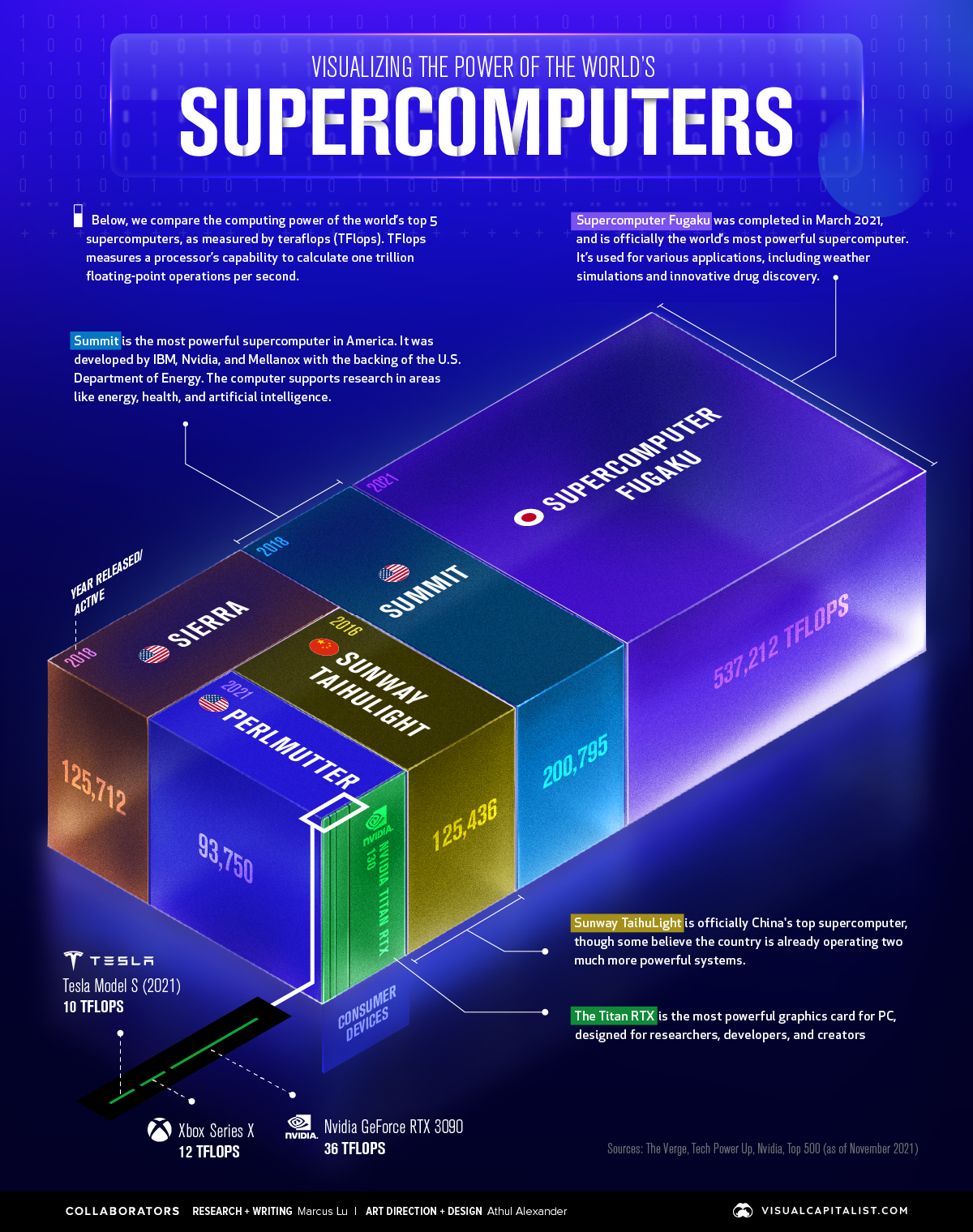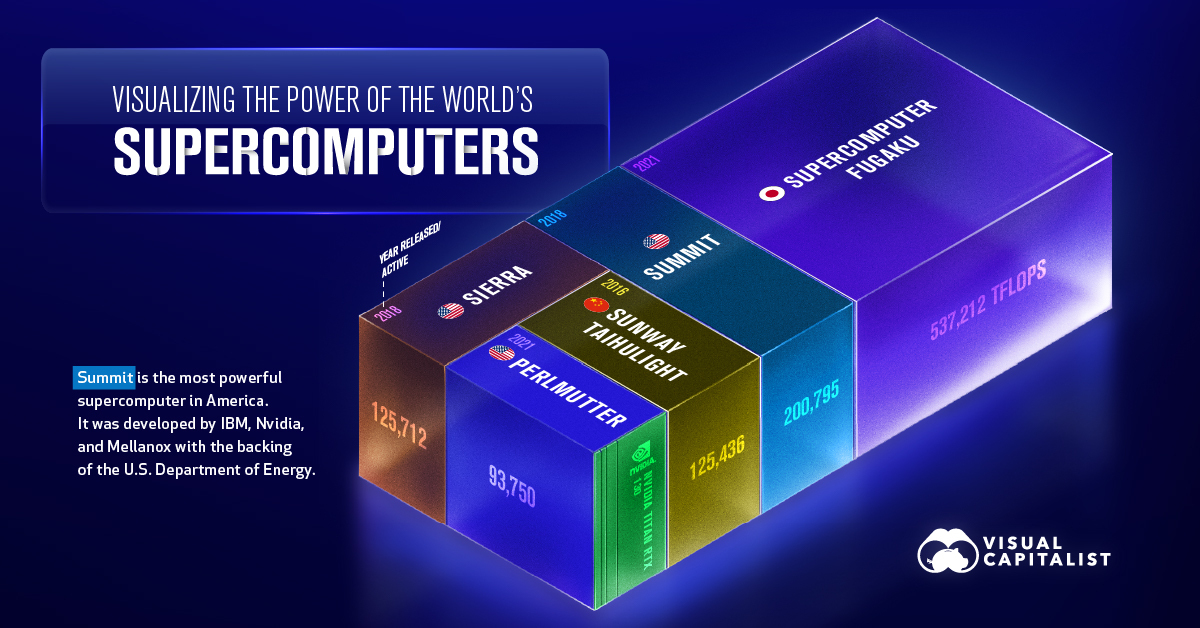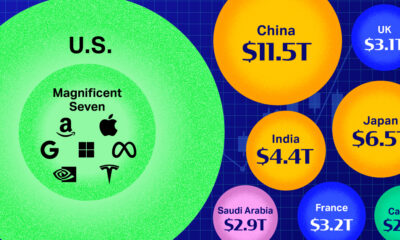Technology
Visualizing the Power of the World’s Supercomputers

Visualizing the Power of the World’s Supercomputers
A supercomputer is a machine that is built to handle billions, if not trillions of calculations at once. Each supercomputer is actually made up of many individual computers (known as nodes) that work together in parallel.
A common metric for measuring the performance of these machines is flops, or floating point operations per second.
In this visualization, we’ve used November 2021 data from TOP500 to visualize the computing power of the world’s top five supercomputers. For added context, a number of modern consumer devices were included in the comparison.
Ranking by Teraflops
Because supercomputers can achieve over one quadrillion flops, and consumer devices are much less powerful, we’ve used teraflops as our comparison metric.
1 teraflop = 1,000,000,000,000 (1 trillion) flops.
| Rank | Name | Type | Teraflops |
|---|---|---|---|
| #1 | 🇯🇵 Supercomputer Fugaku | Supercomputer | 537,212 |
| #2 | 🇺🇸 Summit | Supercomputer | 200,795 |
| #3 | 🇺🇸 Sierra | Supercomputer | 125,712 |
| #4 | 🇨🇳 Sunway Taihulight | Supercomputer | 125,436 |
| #5 | 🇺🇸 Perlmutter | Supercomputer | 93,750 |
| n/a | Nvidia Titan RTX | Consumer device | 130 |
| n/a | Nvidia GeForce RTX 3090 | Consumer device | 36 |
| n/a | Xbox Series X | Consumer device | 12 |
| n/a | Tesla Model S (2021) | Consumer device | 10 |
Supercomputer Fugaku was completed in March 2021, and is officially the world’s most powerful supercomputer. It’s used for various applications, including weather simulations and innovative drug discovery.
Sunway Taihulight is officially China’s top supercomputer and fourth most powerful in the world. That said, some experts believe that the country is already operating two much more powerful systems, based on data from anonymous sources.
As you can see, the most advanced consumer devices do not come close to supercomputing power. For example, it would take the combined power of 4,000 Nvidia Titan RTX graphics cards (the most powerful consumer card available) to measure up to the Fugaku.
Upcoming Supercomputers
One of China’s unrevealed supercomputers is supposedly named Oceanlite, and is a successor to Sunway Taihulight. It’s believed to have reached 1.3 exaflops, or 1.3 quintillion flops. The following table makes it easier to follow all of these big numbers.
| Name | Notation | Exponent | Prefix |
|---|---|---|---|
| Quintillion | 1,000,000,000,000,000,000 | 10^18 | Exa |
| Quadrillion | 1,000,000,000,000,000 | 10^15 | Peta |
| Trillion | 1,000,000,000,000 | 10^12 | Tera |
| Billion | 1,000,000,000 | 10^9 | Giga |
| Million | 1,000,000 | 10^6 | Mega |
In the U.S., rival chipmakers AMD and Intel have both won contracts from the U.S. Department of Energy to build exascale supercomputers. On the AMD side, there’s Frontier and El Capitan, while on the Intel side, there’s Aurora.
Also involved in the EL Capitan project is Hewlett Packard Enterprise (HPE), which claims the supercomputer will be able to reach 2 exaflops upon its completion in 2023. All of this power will be used to support several exciting endeavors:
- Enable advanced simulation and modeling to support the U.S. nuclear stockpile and ensure its reliability and security.
- Accelerate cancer drug discovery from six years to one year through a partnership with pharmaceutical company, GlaxoSmithKline
- Understand the dynamic and mutations of RAS proteins that are linked to 30% of human cancers
Altogether, exascale computing represents the ability to conduct complex analysis in a matter of seconds, rather than hours. This could unlock an even faster pace of innovation.
Brands
How Tech Logos Have Evolved Over Time
From complete overhauls to more subtle tweaks, these tech logos have had quite a journey. Featuring: Google, Apple, and more.

How Tech Logos Have Evolved Over Time
This was originally posted on our Voronoi app. Download the app for free on iOS or Android and discover incredible data-driven charts from a variety of trusted sources.
One would be hard-pressed to find a company that has never changed its logo. Granted, some brands—like Rolex, IBM, and Coca-Cola—tend to just have more minimalistic updates. But other companies undergo an entire identity change, thus necessitating a full overhaul.
In this graphic, we visualized the evolution of prominent tech companies’ logos over time. All of these brands ranked highly in a Q1 2024 YouGov study of America’s most famous tech brands. The logo changes are sourced from 1000logos.net.
How Many Times Has Google Changed Its Logo?
Google and Facebook share a 98% fame rating according to YouGov. But while Facebook’s rise was captured in The Social Network (2010), Google’s history tends to be a little less lionized in popular culture.
For example, Google was initially called “Backrub” because it analyzed “back links” to understand how important a website was. Since its founding, Google has undergone eight logo changes, finally settling on its current one in 2015.
| Company | Number of Logo Changes |
|---|---|
| 8 | |
| HP | 8 |
| Amazon | 6 |
| Microsoft | 6 |
| Samsung | 6 |
| Apple | 5* |
Note: *Includes color changes. Source: 1000Logos.net
Another fun origin story is Microsoft, which started off as Traf-O-Data, a traffic counter reading company that generated reports for traffic engineers. By 1975, the company was renamed. But it wasn’t until 2012 that Microsoft put the iconic Windows logo—still the most popular desktop operating system—alongside its name.
And then there’s Samsung, which started as a grocery trading store in 1938. Its pivot to electronics started in the 1970s with black and white television sets. For 55 years, the company kept some form of stars from its first logo, until 1993, when the iconic encircled blue Samsung logo debuted.
Finally, Apple’s first logo in 1976 featured Isaac Newton reading under a tree—moments before an apple fell on his head. Two years later, the iconic bitten apple logo would be designed at Steve Jobs’ behest, and it would take another two decades for it to go monochrome.
-

 Money2 weeks ago
Money2 weeks agoWhich States Have the Highest Minimum Wage in America?
-

 Misc1 week ago
Misc1 week agoAirline Incidents: How Do Boeing and Airbus Compare?
-

 Environment1 week ago
Environment1 week agoTop Countries By Forest Growth Since 2001
-

 United States2 weeks ago
United States2 weeks agoWhere U.S. Inflation Hit the Hardest in March 2024
-

 Demographics2 weeks ago
Demographics2 weeks agoThe Smallest Gender Wage Gaps in OECD Countries
-

 Markets2 weeks ago
Markets2 weeks agoThe Top 10 States by Real GDP Growth in 2023
-

 Countries2 weeks ago
Countries2 weeks agoPopulation Projections: The World’s 6 Largest Countries in 2075
-

 Travel2 weeks ago
Travel2 weeks agoRanked: The World’s Top Flight Routes, by Revenue


















